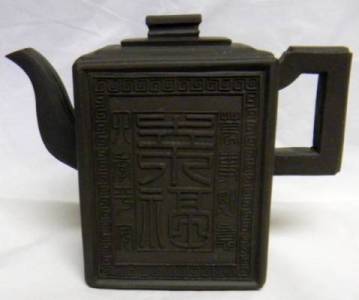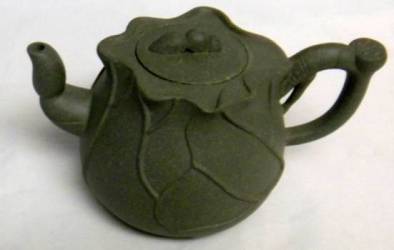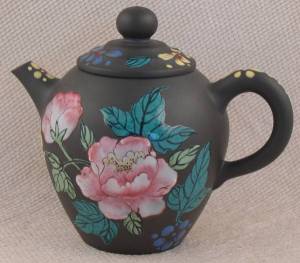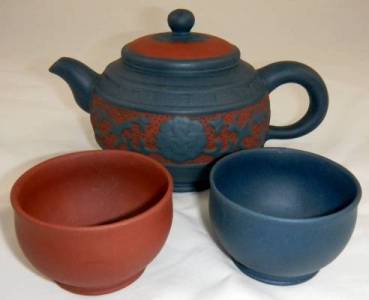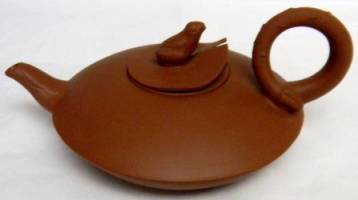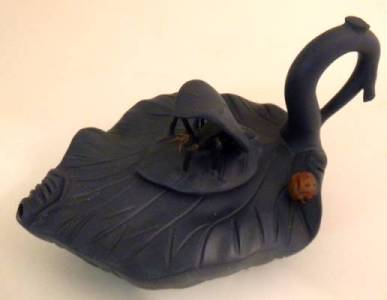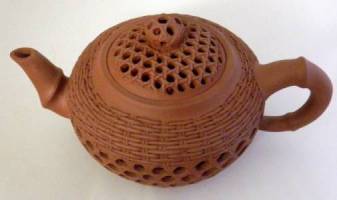Yixing Teapots
History of the Yixing TeapotYixing is a town on the Taihu Lake of Jiangsu Province in China that is known as the ceramic capital of China, because of the purple clay exclusively found in this area. This city has a long tradition of producing Yixing teapots possibly beginning in the Song Dynasty dating back to 960-1279. Fragments from Yixing teapots have been unearthed around a Song Dynasty dragon kiln on Yiang Jiao Mountain of Ding Shu Town. Instances of the teapot being mentioned in poetry dating from this time period have also been noted.
Much more evidence exist that the Yixing teapot was developed in the Ming Dynasty dating back to 1368-1644. Mr. Zhou Gao Qi, a writer who lived during the Ming Dynasty authored an account on the development and production of Yixing teapots. Tea culture also began to change during the Ming Dynasty. The large tea bowl was replaced with smaller teapots since tea leaves and buds became available instead of just tea cakes. The preparation changed from boiling the tea cakes to steeping the tea leaves.
Qing Dynasty (1644-1911) is considered the golden era of the purple clay teapot. During this time, the Yixing teapot proved unique, elegant and highly individualized. Decorating these prized teapots reached new levels by moving beyond just carved calligraphy, but to color, glazing, carved paintings, inlays of gold and silver, hollowing out designs to name a few. Yixing teapots were also modeled into shapes like melons, a leaf with a cicada, peanuts, bamboo trunks, etc. We still see many of these designs in today’s Yixing teapots.
Kang Xi (1661-1722) the second emperor of the Qing Dynasty was a big admirer of these teapots. During his reign, Yixing teapots were exported to Europe and were known as red porcelain. Portugal, the Netherlands and Germany began imitating the designs of the imported Yixing teapots. Mr. Bo Te Ge, a famous German potter produced two thousand pieces of red clay pottery based on the Yixing teapot and also wrote an essay about the red sand porcelain. Kang Xi refused to allow a maker’s mark on the teapots. The Yixing teapots made during his rule carried the title of the emperor’s reign. This rule was carried through during Yongzheng’s reign (1722-1796), as well as Qianlong’s rule (1736-1796). Emperor Qianlong even advocated that his people use Yixing teapots, so of course these purple teapots became very fashionable. At the end of Qianglong rule, the restriction of placing maker’s marks on the teapot ended. Now a great masters and artists alike could place their seal on these special Yixing teapots.
During the last stage of the Qing Dynasty to the very early days of the Republic of China was a prosperous period for the Yixing teapot. Dealers in Shanghai began selling purple clay teapots that were being made in Yixing in Jiangsu Province. As a result of the teapots becoming more mainstream in China, many great masters came forward to produce some very remarkable Yixing teapots that sold for a great deal of money and began garnering awards. One such accomplished master was Cheng Shou Zheng. His Yixing teapot De Ball Pot and archaize (archaize means to give an archaic quality or character to; suggest the past) pot were given the gold award at the Panama International Exhibition in 1919. This made Cheng Shou Zheng the first master to be acknowledged with a gold award during an international exhibit. Through the hard work and dedication shown by many pottery artists and masters have allowed the purple clay teapots to win more world recognition and awards with the most notable being Chicago Exposition, London Arts Expo and Philadelphia Expo.
The production of Yixing teapots continued to escalate between the years of 1919-1937. Many more shops were set up in many Chinese cities such as Shanghai, Hang Zhou, Wuxi, Tiang Jing, Qing Dao to name a few. Branch stores were set up in Japan, Singapore and Philippines.
The War of Resistance against Japan (1937) brought the production of Yixing teapots to a halt when many of the masters went into exile and kilns were destroyed. Not until 1949, when the people were liberated, did the production of Yixing teapots resume. Many of the masters returned to the town of Yixing and state factories were set up too aide in the production of purple clay teapots. The many designs of Yixing teapots now number in the hundreds since many talented craftsmen have entered the field of pottery. One such master was Mr. Gu Jing Zhou (1915-1992) who made a Yixing teapot that was sold for $65,000 in Macau. Today’s artists are still creating new styles, designs and shapes of Yixing teapots to bring even more enjoyment to the simple act of having tea.
Purple ClayYixing teapots are made from special unglazed clay called zisha clay. Zisha, known as purple clay from which Yixing teapots and other wares are made from can be found throughout the hilly southern area of the Yixing China.
Geologists have found the origin of zisha clay in compressed sedimentary lake deposits. There are actually three different varieties of zisha. The most common of these clays is called zini or rose brown clay. The other two other clays are rarer and are called banshanlu or creamy light to light brown clay and zhuni or red clay. Chemically, all three clays are composed primarily of quartz, kaolin, and mica. The different clays also contain a high amount of iron oxide giving them their purple red color. All three types of zisha clays are fairly sandy.
Zisha clay is a type of ore that is a hard rock when first removed from the mine. The clay is laid out on the open ground for several months to be turned into small grains about the size of soybeans by the air, wind and rain. A stone mill crushes the small grains into a powder that is then sifted by a sieve. The powder is now mixed with water to produce wet lumps of crude clay that is beaten with a wood hammer till the clay develops a plasticity that is ready to be shaped into a Yixing teapot or other ware.
Each Yixing teapot is shaped by hand on a pottery wheel and left unglazed to allow the color of the clay to show. The color of the clay is determined by the layering of the clay in the ground. The depth of color is determined by the concentration of iron in the clay. Once properly refined and fired at a high temperature, but a lower temperature than porcelain, the clay produces a Yixing teapot that is slightly absorbent.
A unique characteristic of the zishing clay is its high plasticity. This allows for the individual pieces of the Yixing teapot to be made separately and attached to the body of the teapot before polishing. High plasticity also allows the artist to fully create the teapot they have envisioned along with allowing the artist to use varying techniques to enhance the beauty of their work.
Low contraction rate is another unique characteristic of zisha clay. This gives the Yixing teapot a low deformation range. This means the teapot and lid will fit closely together, no matter the unique shape of the teapot.
A favorite characteristic of purple clay it that no additional materials are needed to make the Yixing teapot. A glaze is unnecessary. This allows the teapot to absorb the flavors of the tea into the body of the teapot. A well seasoned Yixing teapot will brew the perfect cup of tea every time.
One of the best characteristics is the ability of the clay to retain heat. Small pores produced in the clay during firing enable the Yixing teapot to retain heat and the flavor of the tea.
Appreciating a Yixing TeapotPurple clay is midway between earthenware and porcelain. Clays similar to zisha clay in color and appearance can be found in many parts of China and Europe, but they lack the sandy consistency that gives Yixing clay its unique qualities making it perfect for producing delicate teapot and other wares. Yixing teapots not only brew a perfect cup of tea because of their inherent ability to retain heat and absorb the flavor of tea, but also contain an aesthetic beauty that can not be matched by any other type of clay. This aesthetic beauty is derived from the variety of colors, texture, and form a skilled artist can derive from shaping these teapots by hand.
Teapots made from Yixing purple clay are considered superior to all other types of teapots for brewing tea. After prolonged use, a patina will gradually develop on the interior of the teapot that enhances the taste, color and aroma of the tea because of the unglazed pot and porous nature of the clay. The exterior of the teapot will develop a lustrous appearance as the oils from the tea are absorbed through the pot over time and use. Legend states that if a Yixing teapot made from purple clay has been used for a very long time, one can simply pour hot water into the teapot to brew a cup of tea.
The designs and shapes of Yixing teapots and wares can be classified into three main types consisting of natural, geometric and artistic style. The addition of calligraphy, painting, intricate carvings and sculptures are also incorporated into the teapot as a unique expression of Chinese art. Today’s craftsmen and artists not only produce replicas of antique pots, but also create new and innovative designs that contribute to the individual character of each teapot.
Due to the absorbent nature of Yixing teapots will enrich the taste and flavor of tea after a long period of usage. To avoid a mixture of various tea fragrances, it is essential to use just one type of tea per teapot. The more you use the teapot, the richer the interior patina and the more lustrous the surface will become. The quality of the tea brewed, as well as the beauty of the teapot will be enhanced with continued use and care.
Caring for the Yixing TeapotThere are two schools of thought when it comes to preparing a new Yixing teapot for use. The first way is to simmer the teapot and lid in a large pot of water mixed with the type of tea chosen for this teapot. I just wanted to note that following are the steps recommended by most retailers and books that have a chapter on Yixing teapots. I have not found this necessary to do with my personal Yixing teapots.
Recommended Seasoning of Yixing:
- 1. Place the teapot and lid into a pot of water. I would use a towel on the bottom of the pan, so the teapot will not move around and possibly break.
2. Place some tea leaves in the water. Use the same type of tea you plan to brew in your new teapot. Simmer for about an hour. Be very careful not to let the water come to a boil, so your teapot will not move around by the force of the water moving.
3. Turn the heat off and let the teapot cool down in the water.
4. Rinse the teapot well with warm water.
5. Repeat step 1-4 again.
6. Your new teapot is ready to brew your first cup of tea.
These are the steps I use for my Yixing Teapots
- 1. Fill the teapot with warm water and allow to rest for 10 minutes. Drain.
2. Fill the teapot with hot water (not boiling) allow to rest for 10 minutes. Drain.
3. Rinse under cool running water to rid the teapot of any sand that has loosened.
4. Brew a pot of tea using the type of tea this pot was purchased for. Discard the tea.
5. Smell the teapot for any earthy aroma. If the teapot smells fine to you it is ready to use. If you detect an earthy aroma, brew and discard another pot of tea.
Never, ever use soap in your Yixing teapot! The zisha clay will absorb the taste of the soap and will never make a good cup of tea again. Simply rinse the teapot with hot water and allow to air dry. Leave the lid off of the teapot until completely dried.
References: www.yixingteapotsale.com sites.google.com/site/historyofyixingteapot
